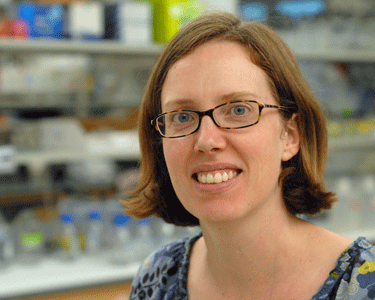Note: This article is over a year old and information contained in it may no longer be accurate. Please use the contact information in the lower-left corner to verify any information in this article.
The science behind excess fat
August 12, 2010
It’s a simple concept: each cell in the human body has the ability to store excess fat in a compartment known as the lipid droplet. This compartment plays an important role in protecting cells from toxic overloads of fat and is key to understanding obesity-related disorders like heart disease and diabetes.
|
|
| Assistant Professor of Biology and Chemistry Laura Listenberger in her lab, where she and three student researchers spent the summer studying how cells store excess fat. |
Yet scientists know surprisingly little about how lipid droplets are formed or what causes them to break down. St. Olaf Assistant Professor of Biology and Chemistry Laura Listenberger is working to change that. Along with the assistance of student researchers Shahid Jaffer '11, Alison Seline '12, and Arthur Sletten '13, Listenberger has spent the summer studying how lipid droplets work.
“My hope is that if we can better understand the mechanisms our cells naturally use to protect themselves from high levels of fat, then we can understand why overloading these systems causes so many health problems,” Listenberger says.
Much of Listenberger’s work uses mammalian cells that she and her student researchers grow in a lab. They bathe the cells in a solution that includes excess fat and examine how the lipid storage compartment grows or changes depending on the proteins in the cell. They can also determine what kinds of proteins and lipids are found in the compartment by breaking open the cells and isolating the lipid storage compartment. “We would like to understand how proteins interact with the lipid droplet and regulate how fat gets into and out of this compartment,” Listenberger says.
To better understand the cellular structure, some of the student researchers are also making model lipid droplets to determine how the structure of this compartment influences its function. Through her research, Listenberger expects to gain insight into how lipid droplets form, what controls the number and size of these storage compartments, how the proteins that control lipid storage find their way to the lipid storage compartment, and how proteins bind to lipid storage compartments.
Listenberger’s interest in lipid droplets began while she was a graduate student at Washington University. Her advisor was a scientist and cardiologist who stressed the important role that fat metabolism and the proper regulation of fat storage play in the heart. Listenberger’s thesis work showed that lipid droplets were important for protecting a cell from the toxicity of lipid overload. While this data demonstrated that the fat storage compartments were necessary cell structures, very little was known about how they formed or degraded.
“I have been interested in pursuing these questions ever since,” she says, noting that some of the most basic questions related to the lipid storage compartment still lack answers. “With each new discovery, more questions become apparent.”

